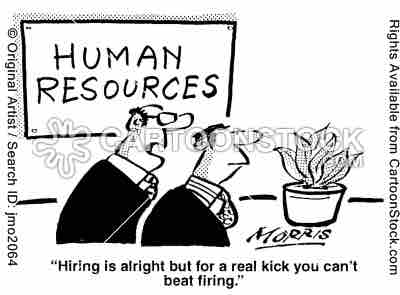Human resource management (HRM, or simply HR) is the management of an organization's workforce, or human resources . It is responsible for the attraction, selection, training, assessment, and rewarding of employees. HR also oversees organizational leadership and culture, and ensures compliance with employment and labor laws.

Human Resource Management
Human resource management is the management of an organization's workforce, or human resources.
Attraction
Employer brand was first used in the early 1990s to denote an organization's reputation as an employer. Since then, it has become widely adopted by the global management community. Employer branding is "the image of your organization as a ‘great place to work.'" Just as a customer brand proposition is used to define a product or service offer, an employee value proposition (EVP) is used to define an organization's employment offer. Likewise, the marketing disciplines associated with branding and brand management have been increasingly applied by the human resources and talent management community to attract, engage, and retain talented candidates and employees.
Selection
The stages in selection include sourcing candidates by networking, advertising, or other methods. The HR recruiter utilizes professional interviewing techniques to understand the candidate's skills, motivations to make a move, and to screen potential candidates using testing (skills or personality). The process is meant to evaluate the candidate and also evaluate how the candidate will fit into the organization. The recruiter will meet with the hiring manager to obtain specific position and type information before beginning the process. After recruiters understand the type of person the company needs, they begin the process of informing their network of the opportunity. Recruiters play an important role by preparing the candidate and company for the interview, providing feedback to both parties, and handling salary and benefits negotiations.
Training
Training and development (T&D) encompasses three main activities: training, education, and development. Garavan, Costine, and Heraty, of the Irish Institute of Training and Development, note that these ideas are often considered to be synonymous. However, to practitioners, they encompass three separate, although interrelated, activities:
Training: This activity is both focused upon, and evaluated against, the job that an individual currently holds.
Education: This activity focuses upon the jobs that an individual may potentially hold in the future, and is evaluated against those jobs.
Development: This activity focuses upon the activities that the organization employing the individual, or that the individual is part of, may partake in the future, and is almost impossible to evaluate.
Assessment
A performance appraisal (PA) or performance evaluation is a systematic and periodic process that assesses an individual employee's job performance and productivity in relation to certain pre-established criteria and organizational objectives. Other aspects of individual employees are considered as well, such as organizational citizenship behavior, accomplishments, potential for future improvement, and strengths and weaknesses.
To collect PA data, there are three main methods: objective production, personnel, and judgmental evaluation. Judgmental evaluations are the most commonly used with a large variety of evaluation methods. A PA is typically conducted annually. The interview could function as "providing feedback to employees, counseling and developing employees, and conveying and discussing compensation, job status, or disciplinary decisions."
Rewarding
Remuneration is the total compensation that employees receive in exchange for the service that they perform for their employer. Typically, this consists of monetary rewards, also referred to as wage or salary, and complementary benefits including healthcare, pension plans, and stock options. The HR department plays a critical role in determining raises or bonuses based on employee performance.